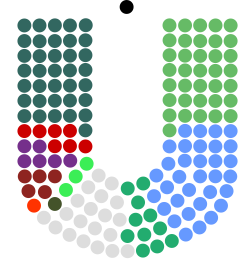Oireachtas Éireann
|
Oireachtas National Parliament |
|
|---|---|
 |
|
| Type | |
| Type | |
| Houses |
Dáil Éireann (32nd) Seanad Éireann (25th) |
| Leadership | |
| Structure | |
| Seats |
218 members
|
 |
|
|
political groups
|
Government (58)
Other Opposition (56)
Ceann Comhairle (1)
|
 |
|
|
political groups
|
Government (19)
Opposition (41)
|
| Elections | |
| Single transferable vote | |
| Indirect election | |
|
last election
|
26 February 2016 |
|
last election
|
26 April 2016 |
| Meeting place | |
 |
|
| Leinster House, Dublin | |
| Website | |
| oireachtas |
|
218 members
Government (58)
Other Opposition (56)
Ceann Comhairle (1)
Government (19)
Opposition (41)
The Oireachtas (/ˈɛrəktəs/; EH-rək-təs), sometimes referred to as Oireachtas Éireann, is the legislature of the Republic of Ireland. The Oireachtas consists of:
The houses of the Oireachtas sit in Leinster House in Dublin, an eighteenth-century ducal palace. The directly elected Dáil is by far the more powerful branch of the Oireachtas.
The term oireachtas (Irish pronunciation: [ˈiːɾʲəxt̪ˠasˠ]) derives from the Old Irish word airech ("nobleman"). Its first recorded use as the name of a legislative body was within the Irish Free State.
Dáil Éireann, the lower house, is directly elected under universal suffrage of all Irish and United Kingdom citizens who are resident and at least eighteen years of age. An election is held at least once in every five years as required by law. However the house can usually be dissolved at any time at the request of the Taoiseach (head of government). Dáil elections occur under the system of proportional representation by means of the single transferable vote. The Dáil has had 166 members since 1981. The Seanad is not directly elected but consists of a mixture of members selected in a number of ways. 43 senators are elected by councillors and parliamentarians, 11 are appointed by the Taoiseach, and six are elected by two university constituencies, giving a total of 60 members. The President of Ireland is directly elected once in every seven years, for a maximum of two terms. However, if, as has occurred on a number of occasions, a consensus among the larger political parties can result in only a single candidate being nominated, then no actual ballot occurs.
...
Wikipedia
